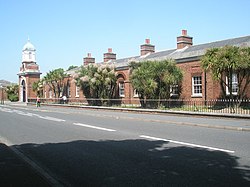
Summary
Forton Barracks was a military installation near Gosport in Hampshire, which served first as an Army barracks and then as a divisional headquarters for the Royal Marines. It subsequently served as a Royal Navy training establishment. Today, the site is occupied by St Vincent College.
Forton Barracks | |
|---|---|
| Gosport, Hampshire | |
 Forton Barracks | |
 Forton Barracks Location within Hampshire | |
| Coordinates | 50°48′00″N 1°08′10″W / 50.800°N 1.136°W |
| Type | Royal Marines Base |
| Site history | |
| Built | 1807 |
| Built for | Admiralty |
| In use | 1807-1923 |
| Garrison information | |
| Occupants | Portsmouth Division, Royal Marines |
History edit
Towards the end of the 18th century the owner of Forton Mill sold an adjacent parcel of land to the Board of Ordnance, to serve as the site for an Army General Hospital. Forton Military Hospital was begun in 1797;[1] by 1800, however, soldiers were being treated at the nearby Naval hospital at Haslar, so the decision was taken to alter the proposed hospital buildings to serve as a barracks instead.[2] The Barracks opened in 1807, consisting of four tall pavilions connected by arcades (an arrangement very similar to that of the contemporary military hospitals at Plymouth and Deal).[1] The pavilions faced the main entrance gate (which was flanked by officers' quarters) across a sizeable parade ground, believed for a time to have been the largest in the country.[2] Over the next forty years the barracks housed a succession of different regiments.[3] The pavilions were capable of accommodating 832 men plus 48 sergeants; however by the 1840s one pavilion was still serving as a hospital, another had had its ground floor converted into the officers' mess and elsewhere space was taken up by school rooms, workshops and stores.[4]
At this time the Portsmouth Division of the Royal Marines resided in Old Portsmouth in premises which had formerly been a 17th-century brewery and cooperage: Clarence Barracks.[1] Fast outgrowing their accommodation there, an arrangement was reached whereby the Board of Ordnance exchanged Forton Barracks for Clarence (which was adapted to accommodate troops of the garrison Artillery), allowing the Marines to move into Forton. To accommodate a full Royal Marine division, the barracks needed to expand: Captain Henry James R.E. oversaw the project, which included provision of a large officers' mess, along with additional officers' accommodation, to the east of the parade ground and a sergeants' mess west of the pavilions. The officers' mess included space upstairs for 80 diners plus a 30-piece orchestra, with a library and breakfast room provided downstairs along with kitchens to the rear. James also built two long single-storey blocks (to serve as a school and as offices) either side of the main gate, which he expanded with the addition of a clock tower, and he provided various buildings for stores and other amenities behind the main barrack blocks.[4]
The Royal Marines took possession of the barracks in 1848.[5] Shortly afterwards they were retitled the Royal Marine Light Infantry (to distinguish them from the Royal Marine Artillery, who had their own separate barracks alongside the Gunwharf on the other side of the harbour).[6] In 1858 the mill and millpond were purchased by the Admiralty; the millpond was drained became part of the site. By 1862 additional barrack blocks had been built between the old pavilions so as to accommodate the full complement of over 1000 men;[3] further expansion, with the construction of married quarters for officers, took place in the 1890s.[2] A 400-seater theatre was built within the site in 1893.[5]
In 1922 defence cuts meant that Portsmouth Division of the Royal Marine Light Infantry and the Royal Marine Artillery were amalgamated. The newly created Portsmouth Division of the Royal Marines moved to Eastney Barracks in August 1923 leaving the site empty.[2]
In 1927 the Barracks were recommissioned as HMS St. Vincent creating a Royal Naval training establishment for boy seamen and juniors.[7] It continued as a shore establishment with the Royal Navy until 1969.[2]
Cadets edit
In 1904 a division of the Royal Marines Light Infantry Cadet Corps was established. This was based on the successful Royal Marines Artillery Cadet Corps at Eastney Barracks and was part of the Royal Navy's Volunteer Cadet Corps. The Forton Division RMLI Cadet Corps closed some years later but today's Gosport Division Royal Marines Volunteer Cadet Corps carries on its traditions albeit based at HMS Sultan.[8]
Gallery edit
-
Royal Marines Squad M23 at Forton Barracks in 1917
-
Wartime parade at HMS St Vincent; in the background is the Officers' Mess of 1848
-
Parade ground, HMS St Vincent; beyond it, the original pavilions of 1807
-
The 1807 arcade linking together the pavilions of the old barracks
-
HMS St Vincent: inside the main gate
References edit
- ^ a b c Douet, James (1998). British Barracks 1600-1914: their Architecture and Role in Society. London: The Stationery Office. p. 49.
- ^ a b c d e "Forton Road Conservation Area Appraisal". Gosport Council. Archived from the original on 4 August 2016. Retrieved 28 May 2016.
- ^ a b "Forton Barracks". Historic Gosport. Retrieved 20 July 2019.
- ^ a b James, Captain (1852). "Additions to the Barracks at Forton to Accommodate the Portsmouth Division of Royal Marines". Papers on subjects connected with the Duties of the Corps of Royal Engineers. II: 101–105.
- ^ a b "St Vincent". Gosport Heritage. Retrieved 28 May 2016.
- ^ Underwood, Michael (2015). Gunwharf Quays: The History, Architecture, Conservation and Development of a Remarkable Military Site. Portsmouth: Tricorn Books.
- ^ "Forton Barracks". Royal Navy Research Archive. Retrieved 28 May 2016.
- ^ "History of the RMVCC". Volunteer Cadet Corps. Retrieved 27 January 2021.


